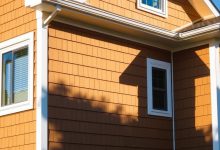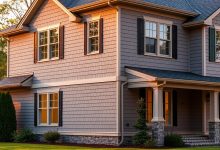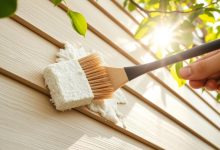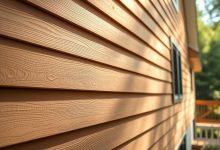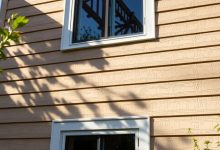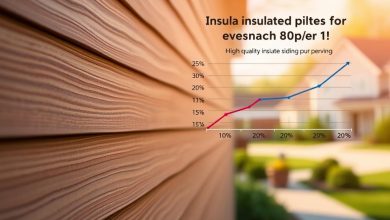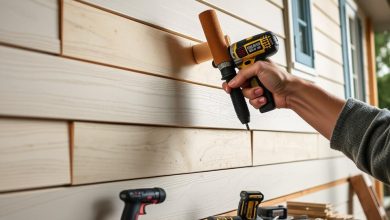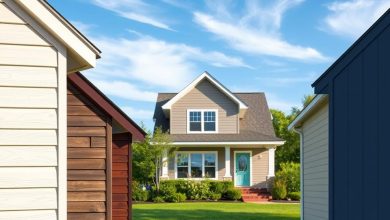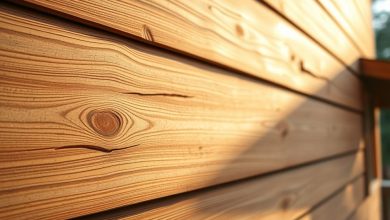Fiber Cement Insulated Siding: Durable, Energy-Efficient Protection
Homeowners in the United States are looking for modern ways to protect their homes. They want something that’s both strong and saves energy. Fiber cement insulated siding is becoming popular because it can handle tough weather and cut down on energy use.
This durable siding material makes homes look better and keeps them safe from the weather. By picking energy-efficient siding, homeowners can make their homes cozier. They also get to save money on their energy bills.
Key Takeaways
- Durable and long-lasting exterior protection
- Enhances energy efficiency, reducing energy bills
- Withstands harsh weather conditions
- Aesthetic appeal with various design options
- Robust barrier against environmental elements
Understanding Modern Home Exterior Protection
Energy costs are going up, and so are worries about the environment. Homeowners want solutions that protect their homes and save energy. They also want to help the planet.
Modern exterior protection does more than just shield your home. It also makes it more energy-efficient. The right siding can keep your home cooler in summer and warmer in winter. This means lower bills and less harm to the environment.
The Evolution of Home Siding Materials
Siding materials have changed a lot over time. We’ve moved from wood and vinyl to fiber cement. The right siding is key for a home’s strength, upkeep, and energy use.
- Traditional Materials: Wood, vinyl, and aluminum have been around for years. But they have their limits when it comes to lasting power and saving energy.
- Modern Alternatives: Fiber cement insulated siding is a better choice. It’s stronger, saves more energy, and needs less upkeep.
The Need for Energy-Efficient Building Envelopes
The building envelope, including walls, windows, and roof, is vital for energy use. A well-insulated envelope means less need for heating and cooling. This cuts down on energy costs.
Studies show more people want energy-saving building materials. This is because of higher energy prices and environmental worries. Fiber cement insulated siding is a top pick for its durability and energy-saving benefits.
Energy-efficient building envelopes offer many advantages:
- Less energy use
- Lower bills
- Better comfort and air quality inside
- Less harm to the environment
What Is Fiber Cement Insulated Siding?
Fiber cement insulated siding is changing how we protect our homes. It mixes the toughness of fiber cement with insulation’s energy-saving benefits. This makes it a strong and efficient choice for the outside of buildings.
This siding looks good, lasts long, and saves energy. It’s made to handle different weather conditions. It also keeps the inside of a building warm in winter and cool in summer.
Core Components and Construction
The main parts of fiber cement insulated siding are:
- Fibers: Usually cellulose, these fibers add strength and flexibility.
- Cement: This is the main glue, making the siding hard and durable.
- Insulation: This part, like foam, helps keep the siding warm or cool.
- Additives: These are added to make the siding easier to work with, pest-resistant, or protect it from UV rays.
To make the siding, these parts are mixed and shaped into planks or panels. These are easy to put on houses.
| Component | Function | Benefits |
|---|---|---|
| Fibers | Provides strength and flexibility | Improves durability and resistance to cracking |
| Cement | Acts as the primary binder | Enhances hardness and weather resistance |
| Insulation | Reduces heat transfer | Improves energy efficiency and reduces heating/cooling costs |
Historical Development and Innovation
Fiber cement siding has been around for decades. It started in the 1980s, thanks to James Hardie. Over time, it has gotten better with new technologies and materials.
“The development of fiber cement insulated siding represents a significant step forward in exterior cladding, combining the best attributes of fiber cement with advanced insulation technologies.”
Its history shows a lot of research and improvement. This has led to siding that is more energy-efficient and durable for today’s homes.
The Science Behind Fiber Cement Insulated Siding
Fiber cement insulated siding uses advanced manufacturing process and insulation integration technologies. It’s not just a simple exterior. It’s a complex system for durability, energy efficiency, and looks.
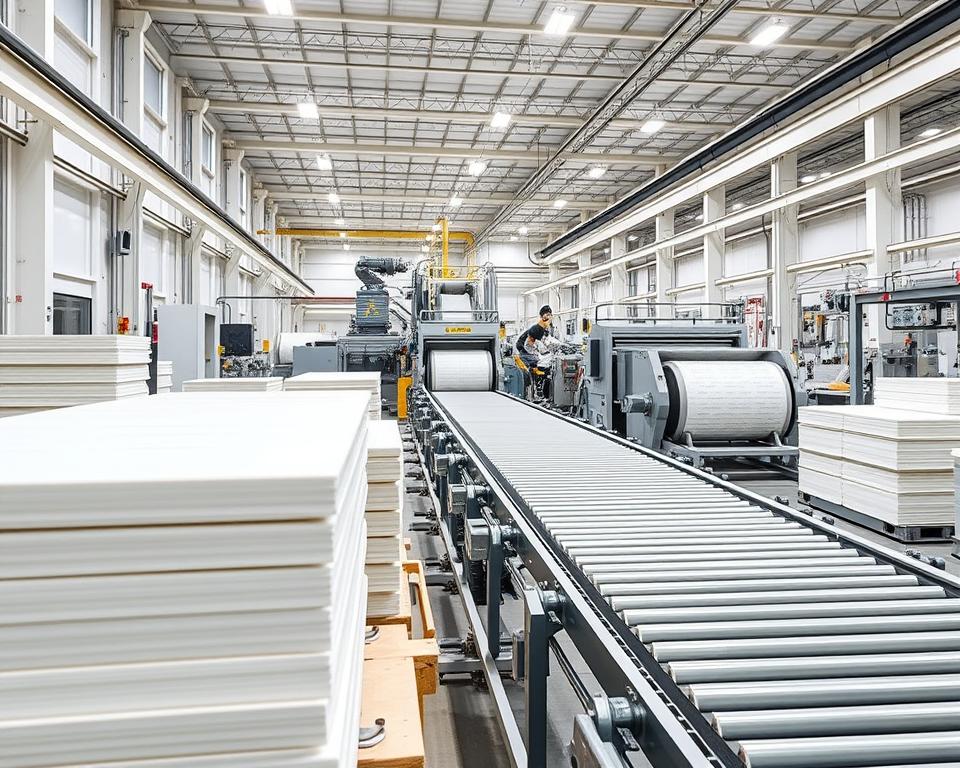
Manufacturing Process and Materials
The making of fiber cement insulated siding mixes cement, cellulose fibers, and additives. This creates a strong and durable board. Modern methods have made this siding better, as Build.com notes.
The materials are picked for strength, weight, and cost. The process mixes the materials, forms sheets, and cures them under control.
Insulation Integration Technologies
Insulation integration is key in fiber cement insulated siding. Several technologies are used to add insulation, including:
Foam Backing Systems
Foam backing systems add foam insulation to the siding’s back. This creates a solid insulation layer. It cuts down on heat loss and boosts energy efficiency.
Composite Insulation Methods
Composite insulation methods mix different insulation materials for better performance. This can include foam and other materials for top-notch insulation.
A study found that composite insulation boosts building thermal performance. This leads to energy savings and lower heating and cooling costs.
“The integration of insulation into fiber cement siding represents a significant advancement in building technology, improving energy efficiency and reducing environmental impact.”
| Insulation Method | Description | Benefits |
|---|---|---|
| Foam Backing Systems | Attaching foam insulation to the back of the siding | Reduces thermal bridging, improves energy efficiency |
| Composite Insulation Methods | Combining different insulation materials | Superior thermal performance, energy savings |
Durability Features and Weather Resistance
Fiber cement insulated siding is tough and can handle harsh weather. It’s made to last, protecting homes from the elements. This makes it a favorite among homeowners.
Its durability comes from its strong build and insulation. This not only makes it weather-resistant but also energy-efficient.
Impact and Hail Resistance
Fiber cement insulated siding is impact-resistant. This is key in areas hit by hail or other impacts. Its dense material absorbs and spreads out impact forces, lowering damage risk.
ExteriorSiding.com says fiber cement siding can handle hail and impacts well. It shows it’s reliable in tough weather.
Moisture and Rot Prevention
Fiber cement insulated siding stops moisture infiltration and rot. Its design and materials form a barrier against moisture damage.
- Resists moisture penetration
- Prevents rot and decay
- Maintains integrity over time
Pest Resistance Benefits
Fiber cement insulated siding is pest-resistant. This is a big plus over other materials that pests can damage.
Its composition doesn’t attract pests. This keeps homes safe from pest damage.
UV and Color Stability
The UV stability of fiber cement insulated siding means it keeps its color and shape. This is true even when it’s exposed to lots of sunlight.
This is great for keeping homes looking good. It stops fading and color changes.
Energy Efficiency Advantages of Fiber Cement Insulated Siding
Fiber cement insulated siding is very energy efficient. It can cut down on energy use a lot, as shown by the EPA.gov. This not only lowers utility bills but also helps the environment.
Understanding R-Values and Thermal Performance
The R-value shows how well a material keeps heat out. Fiber cement siding has high R-values. This means homes stay warm in winter and cool in summer.
Key benefits of high R-values include:
- Reduced heat loss during winter
- Minimized heat gain during summer
- Lower energy bills
Reducing Thermal Bridging
Thermal bridging happens when insulation gaps let heat through. Fiber cement siding helps avoid this. It makes homes more energy efficient and keeps temperatures steady.
Year-Round Climate Control Benefits
Fiber cement siding keeps your home comfortable all year. It keeps warmth in during cold months and cool in warm months. This makes your home more comfortable and saves on energy costs.
The benefits of year-round climate control include:
- Enhanced indoor comfort
- Reduced energy consumption
- Potential for longer HVAC system lifespan
Design Options and Architectural Versatility
Fiber cement insulated siding is perfect for many home styles. It comes in lots of design options. This lets homeowners make their exterior look just how they want.
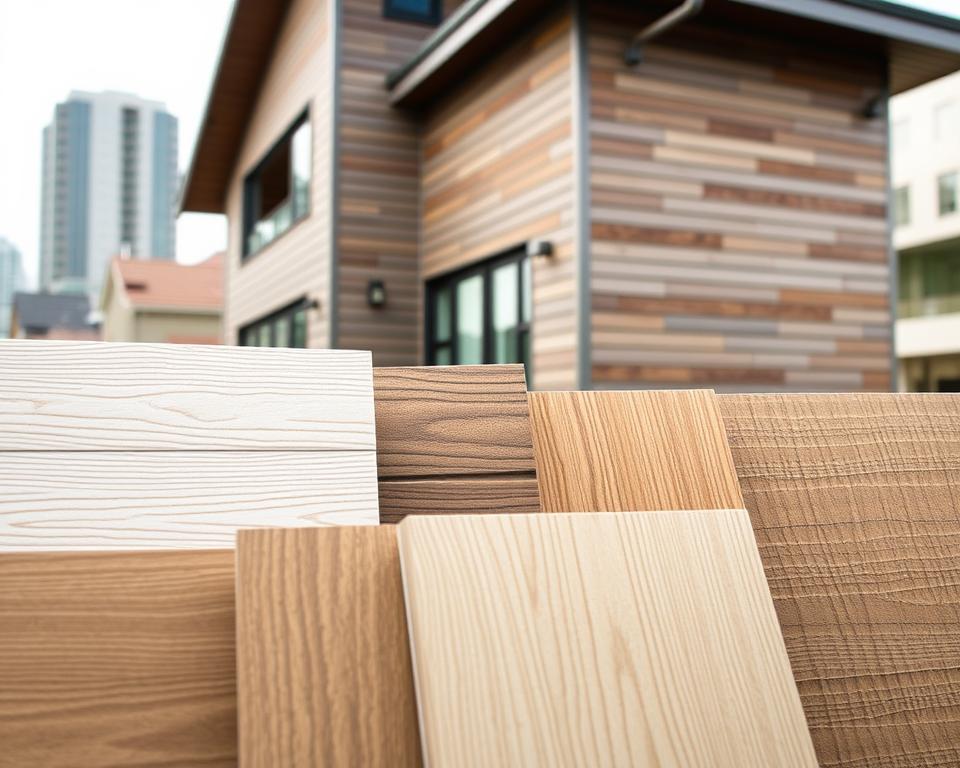
Color Selections and Finish Options
Fiber cement siding has a wide range of colors and finishes. Sherwin-Williams says it comes in many colors and textures. This gives homeowners lots of choices to find the perfect look.
Key color and finish options include:
- Various color palettes to match different home styles
- Fade-resistant finishes to maintain color integrity
- Options for smooth or textured finishes
Texture and Style Variations
Fiber cement siding comes in many textures and styles. You can choose from simple to wood-like textures. This lets homeowners pick the look they like best.
The benefits of these variations include:
- Ability to replicate the look of other materials like wood
- Enhanced aesthetic appeal with varied textures
- Flexibility to match or contrast with other exterior elements
Complementing Different Home Architectures
Fiber cement siding works well with many home styles. It fits modern and traditional homes alike. Its design flexibility makes it easy to match with different architectural elements.
Some of the architectural styles it complements include:
- Modern homes with clean lines and minimalistic designs
- Traditional homes with classic elements like gables and columns
- Craftsman-style homes with their characteristic details
Professional Installation of Fiber Cement Insulated Siding
Installing fiber cement insulated siding needs careful planning and execution. Experts like James Hardie stress the importance of proper installation. It’s key for the siding to work well.
Pre-Installation Requirements
Before starting, make sure the wall is ready. Look for damage or rot and fix it. Also, check that the wall is straight and even.
Step-by-Step Installation Process
The process has several important steps:
- Wall preparation techniques to ensure a smooth surface
- Proper fastening methods to secure the siding
- Sealing and finishing to protect against the elements
Wall Preparation Techniques
Clean the wall surface first. Then, check for any bumps or dips. Make sure the wall is strong enough.
Proper Fastening Methods
Choosing the right fasteners is key. They should not harm the siding and keep it in place. Corrosion-resistant nails or screws work best.
Sealing and Finishing
After putting it up, seal any gaps. Then, finish the siding as the maker suggests. This keeps it looking good and lasting long.
Common Installation Challenges and Solutions
Installers often run into problems like uneven walls, wrong fasteners, and sealing troubles. Knowing these issues and how to fix them can make the job better.
| Challenge | Solution |
|---|---|
| Uneven Surfaces | Use shims or adjust the siding to level it |
| Incorrect Fastening | Use manufacturer-recommended fasteners and follow guidelines |
| Sealing Issues | Apply sealant according to manufacturer’s instructions |
Cost Analysis and Return on Investment
Fiber cement insulated siding offers a great return on investment. It saves energy and lasts a long time. Even though it costs more at first, it’s worth it in the long run for homeowners.
Initial Investment Considerations
The cost of fiber cement insulated siding includes materials and installation. It might cost more than other siding options at first. But, its durability and energy savings make it a smart choice.
Energy.gov says the cost can be paid back by saving energy over time. Think about your home’s size, installation complexity, and product choices when figuring out the cost.
Long-Term Energy Savings Calculation
Fiber cement insulated siding saves a lot of energy. It cuts down on heat loss and improves insulation. This means big savings on heating and cooling bills.
For example, a well-insulated home can save up to 30% on energy costs, says the U.S. Department of Energy.
Here’s how you can break down energy savings:
- Less heat cost in winter
- Lower cooling cost in summer
- Better energy efficiency overall
| Energy Savings Component | Typical Savings | Long-Term Impact |
|---|---|---|
| Heating Costs | 15% – 25% | Lower utility bills |
| Cooling Costs | 10% – 20% | Reduced energy consumption |
| Overall Efficiency | 20% – 30% | Enhanced comfort and reduced energy waste |
Available Tax Credits and Incentives
Installing fiber cement insulated siding might make you eligible for tax credits and incentives. This can make the project even more financially appealing.
“The
offers various incentives for energy-efficient home improvements, including siding that meets certain performance standards.”
These incentives can help cover some of the initial costs. This makes the project more financially viable.
It’s a good idea to check with local and federal authorities for available tax credits and incentives for energy-efficient siding.
Maintenance and Longevity of Fiber Cement Insulated Siding
To keep your fiber cement insulated siding in top shape, regular care is key. Keeping it clean and well-maintained ensures it looks good and works well for years.
Routine Cleaning and Maintenance Schedule
Cleaning your siding regularly is important. Dirt and grime can harm it if left unchecked. Clean it once a year with a soft brush and mild soap. This simple step can make your siding last longer, as ExteriorSiding.com points out.
Repair Techniques for Minor Damage
Fixing small problems like cracks or dents is easy. Use a patching compound that matches the siding to cover these issues. Fixing them quickly helps avoid bigger problems later.
Expected Lifespan and Warranty Coverage
Fiber cement siding is very durable, lasting 30 to 50 years or more. Its lifespan depends on how well you take care of it and the weather. Most makers offer warranties from 15 to 30 years, giving you confidence in your choice.
| Maintenance Task | Frequency | Benefit |
|---|---|---|
| Cleaning | Annually | Prevents grime buildup |
| Inspect for Damage | Bi-Annually | Early detection of issues |
| Caulk Inspection/Replacement | Every 5-10 years | Maintains siding integrity |
Conclusion: Making the Right Siding Choice for Your Home
Choosing the right siding for your home is very important. It affects how your home looks, its energy use, and how long it lasts. We’ve talked about the benefits of fiber cement insulated siding, like its strong build and energy-saving features.
Fiber cement insulated siding is great because it’s durable, weather-resistant, and saves energy. This makes it a good choice for homeowners who want to improve their home’s look and function. By learning about this siding, homeowners can make smart choices for their home improvement projects.
The benefits of fiber cement insulated siding go beyond just looks. It can save you money in the long run and make your home more comfortable. If you’re building a new home or updating an old one, think about using fiber cement insulated siding. It’s a smart move for your home improvement plans.

